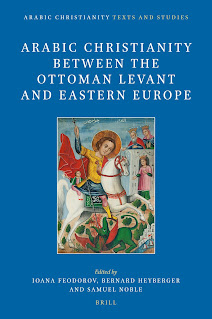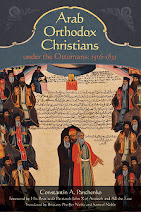To go along with the last post about the historiography of the 1724 schism, I thought I'd post a translation of one of the better summaries of the events of that time written from a self-consciously Roman Catholic perspective, which is often overlooked because it was published in German.
The following is translated from Wilhelm de Vries, Rom und die Patriarchate des Ostens (Freiburg and Munich: Karl Alber, 1963), 88-91.
The Melkite Patriarchates of Antioch, Jerusalem and Alexandria had been represented at the Council of Florence and had accepted the union there, although it had difficulty effectively coming through. Whether it was already renounced in 1443 at a synod of the three patriarchs in Jerusalem is debated.[1] In any case, the Union of Florence was expressly rejected at a council in Constantinople where the Eastern Patriarchates were also represented. Many Catholic Melkites today defend the thesis that the Melkites of the Patriarchate of Antioch have in fact never been schismatic. According to them, the schism first arose through the creation of the Catholic hierarchy in 1724. The opposition to this overly-strict binding to Rome would have led to the schism.[2] This thesis is unacceptable. Even more recently, Joseph Nasrallah has clearly shown that in the period between the Council of Florence and the establishment of the Catholic hierarchy, the Antiochian Church also tied to the undoubtedly schismatic Constantinople in the closest possible way. Such a bond does not agree with a true union with Rome.[3] This view is entirely compatible with that of of Charon (C. Korolevskij) that up to that time there had always been in the Patriarchate of Antioch a party favorable to union, which was also sometimes able to occupy the patriarchal throne.[4] The Apostolic Nuncio Leonardo Abel, who in the time of Gregory XIII also sought to win the Melkites for the union in any case saw them as schismatics.[5]
Serious work for union, however, also began among the Melkites first with the arrival of new missionaries after the foundation of the Propaganda. Over the course of the 17th century, the Latin missionaries were already able to win over one or another patriarch or bishop and many of the faithful for the union. Here too, those who converted to Catholicism remained within the framework of the previously generally schismatic community. A clear distinction between Catholics and non-Catholics only came about through the election of Cyril Tanas as patriarch in 1724. Rome’s ever-stricter regulations against liturgical fellowship with non-Catholics made this split necessary. Towards the end of the 17th century, Patriarch Athanasius III, who had already been elected with the support of the Catholics and the French consul in Aleppo, made a Catholic profession of faith (1687). He probably also did that in order to contend with his rival, Cyril V.[6] As a result, Rome recognized him without any further formalities as the legitimate pastor of his flock. This flock was partly made up of Catholics, but still probably to a greater extent of schismatics. When Cyril V also made a Catholic profession of faith in 1716, Rome preferred to have the Patriarch Athanasius resign, which he accepted in 1717. After Cyril’s death (1720), however, he became patriarch again, but now behaving in a very anti-Catholic manner. Cyril’s position was not clearly Catholic either. Both patriarchs, however, died as Catholics, Athanasius in 1724.
Much more important for the commencement of a real reunification than these patriarchs of dubious sentiment was the absolutely sincerely Catholic Archbishop of Tyre and Sidon, Euthymius Sayfi. Cyril V, who at the time was still undoubtedly schismatic, had elevated him to this dignity in 1683. Already in that year, Euthymius recognized the Pope as his head. In 1701, Rome gave this bishop jurisdiction over all the Catholics of the Patriarchate of Antioch who did not have their own bishop, which incidentally is also a sign that they did not have much trust in Athanasius in Rome. Probably under the influence of the missionaries, Euthymius demonstrated a strong inclination to transform the rite in a Latinizing manner. But Rome did not agree to this at all. Euthymius died in 1723.
After the death of Patriarch Athanasius in Aleppo the following year, the Catholics in Damascus saw that the moment had arrived to bring an undoubtably Catholic man to the top of the patriarchate. The clergy and people of Damascus elected the late Archbishop Euthymius’ nephew, Seraphim Tanas, who took the name Cyril. He was already from a Catholic family and had studied in Rome. After it was transferred from Antioch, Damascus was the patriarchal seat and so, according to ancient Eastern practice, the clergy and the people had the right to choose their bishop, who at the same time was also patriarch. None of the bishops took part in the election, since they had all been summoned to Aleppo following the death of Athanasius. In Damascus, they wanted to get ahead of the opponents of union and so wanted to elect a Catholic as head of the patriarchate as quickly as possible. The electors in now way intended to split the patriarchate and install a patriarch only for the Catholic part. That is clear from the fact that non-Catholics also took part in the election. Efforts were immediately made to have the sultan recognize Cyril as head of the entire patriarchate. Since the pasha of Damascus also supported the petition, there seemed to be a good hope of achieving their goal.
In fact, the opponents of union elected a nephew of the late Athanasius, who had been designated by him as his successor, as patriarch with the name Sylvester. He was consecrated in Constantinople, a week after Cyril’s consecration. Sylvester did not immediately show himself to be a clear opponent of the Catholics. This explains why he initially had followers among the Catholics, even among the missionaries in Aleppo; he had, after all, been designated by the dying Catholic Patriarch Athanasius. Also with the help of the British ambassador in Constantinople, Sylvester obtained the decree of recognition from the sultan and even won over the French ambassador to his side. He soon appeared as a persecutor of the Catholics and demanded that all sign an anti-Catholic profession of faith. Cyril could not remain in Damascus and found refuge in the mountains of Lebanon, from where he ran his patriarchate. Only for a short time did he obtain recognition from the sultan. Sylvester finally had the upper hand and at a synod in Constantinople in 1728, together with the patriarchs of Constanitople and Jerusalem, he hurled an excommunication at Cyril and his followers. Thus, the patriarchate was clearly split into Catholic and anti-Catholic halves, each with its own patriarch and bishops. The reason for this was the choice of the undoubtedly Catholic Cyril Tanas. In the long run, the clear division between Catholics and non-Catholics could not be avoided.
After some hesitation, Rome recognized Patriarch Cyril Tanas (1729). The basis for the hesitation was doubts about the validity of the election and inconvenient information about Cyril’s latinizing tendencies. Above all, he wanted to ease the Greeks’ hard fasts. Later developments proved him right about this. Easing of fasting rules was unstoppable in the long term. At the time, however, Rome did not want to know anything about it, so as not to create an obstacle for the reunification of those still separated. These difficulties delayed the granting of the pallium to Cyril until 1744.[7] With Cyril Tanas begins the unbroken line of undoubtedly Catholic Melkite patriarchs of Antioch. In 1772 the Holy See assigned all Catholics of the Byzantine Rite, including those of the Patriarchates of Jerusalem and Alexandria, to the Patriarchate of Antioch.[8]
[1] See J. Gill, The Council of Florence (Cambridge, 1959), 353-354. Also notes 1 and 2.
[2] B. Homsy, Les capitulations et la protection des chrétiens au Proche Orient au XVI, XVII, et XVIII siècles (Harissa, 1956), 361.
[3] J. Nasrallah, “Chronologie des Patriarches Melchites d’Antioche de 1500-1634,” Proche-Orient Chrétien 7 (1957), 26ff and continuations.
[4] J. Charon, “L’Eglise grecque melchite catholique,” Echos d’Orient 4 (1900-1901), 331.
[5] d’Avril, “Relation de l’évêque de Sidon,” ROC 3 (1898), 4ff.
[6] On the following, see: de Vries, “Der selige Papst Innozenz XI…” OCP 23 (1957), 45ff.
[7] Mansi 46, 37ff.
[8] Mansi 46, 581-582.







